Updated 2026 NFL Draft Order
Several dominoes have fallen so far in Week 16 with respect to the NFL’s playoff picture. The Cowboys have been eliminated while the Patriots, Seahawks, Bears, Eagles and 49ers have locked in a postseason berth.
The final two weeks of the campaign will determine the remaining playoff spots, but they will also sort out the top of the draft order. Six teams remain within striking distance of the No. 1 pick, although the Titans’ win on Sunday greatly weakened their chances of landing the top selection for the second year in a row. One contest in particular will be worth monitoring next week with respect to draft positioning.
The Giants and Raiders each sport a record of 2-13. They will play each other in Week 17, meaning the loser of that contest will have the inside track for the No. 1 pick. New York already has a head coaching vacancy while Pete Carroll is in danger of going one-and-done in Vegas. Plenty of incentive for winning will exist for Carroll in particular, but the outcome of that game will have major implications on the draft order.
For non-playoff teams, the draft order is determined by the inverted 2025 standings plus a series of tiebreakers, starting with strength of schedule. Playoff squads are slotted by their postseason outcome and the reverse order of their regular season record.
Here is an updated look at the first-round order:
- New York Giants (2-13)
- Las Vegas Raiders (2-13)
- Cleveland Browns (3-12)
- New York Jets (3-12)
- Arizona Cardinals (3-12)
- Tennessee Titans (3-12)
- Washington Commanders (4-11)
- New Orleans Saints (5-10)
- Cincinnati Bengals (5-10)
- Miami Dolphins (6-9)
- Los Angeles Rams (via Falcons)
- Kansas City Chiefs (6-9)
- Dallas Cowboys (6-8-1)
- Baltimore Ravens (7-8)
- Minnesota Vikings (7-8)
- Tampa Bay Buccaneers (7-8)
- Detroit Lions (8-7)
- New York Jets (via Colts)
- Carolina Panthers (8-7)
- Pittsburgh Steelers (9-6)
- Dallas Cowboys (via Packers)
- Philadelphia Eagles (10-5)
- Houston Texans (10-5)
- Buffalo Bills (11-4)
- Los Angeles Chargers (11-4)
- San Francisco 49ers (11-4)
- Cleveland Browns (via Jaguars)
- Los Angeles Rams (11-4)
- Chicago Bears (11-4)
- New England Patriots (12-3)
- Denver Broncos (12-3)
- Seattle Seahawks (12-3)
Cowboys To Evaluate DC Matt Eberflus After 2025 Season
In recent weeks, Matt Eberflus‘ stock has taken a number of hits. That continued today during the Cowboys’ lopsided loss against the Chargers. 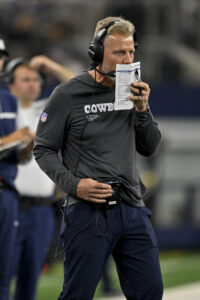
Dallas lost 34-17 to Los Angeles on Sunday. The Cowboys entered Week 16 ranked 31st in scoring defense and and dead last against the pass. Especially with those figures emerging after mid-season reinforcements (via trade and players returning to health) on defense, Eberflus’ job security has increasingly become a talking point.
No moves in the immediate future will be coming on the sidelines, though. When speaking to the media after the game, Cowboys owner Jerry Jones said (via Jon Machota of The Athletic) there will not be any firings made during the final two weeks of the season. Full evaluation of all coaches – which of course includes Eberflus – will take place after the campaign has ended.
That ensures Eberflus will remain in place for two more weeks at a minimum. Beyond that point, though, it will be interesting to see if the former Bears head coach is retained for 2026 or not. Dallas has struggled in numerous departments on defense for much of the season, one in which a turnaround seemed to be taking place during a three-game winning streak. Since then, however, the Cowboys have dropped three in a row while allowing at least 34 points each time.
Eberflus has received an endorsement on multiple occasions in 2025. Head coach Brian Schottenheimer and COO Stephen Jones are among those who have backed the 55-year-old, but things have not gone according to plan on defense for most of the year. Mike Zimmer proved to be a one-and-done defensive coordinator for Dallas in 2024, and a similar situation could be playing out in Eberflus’ case.
“I should, if I’m anything, know and have accessibility to the greatest choices that you could have regarding coaches,” Jones said (via Machota). “That doesn’t mean you can get them all, because they may be committed in other ways. But one of the great things about where we are and what we got is we can get good coaches. That’s not crossed my mind, as far as the inability to effectively do something different if that’s what we decide.”
Based on those comments, Jones and the Cowboys will certainly look into the possibility of finding a new DC through an external hire or an internal promotion. Eberflus is a familiar face in the organization based on his tenure as LBs coach from 2011-17, something which will no doubt factor into the team’s decision. A final call will not be made for the time being, but the possibility of a firing shortly after the season ends will remain something to watch for.
Minor NFL Transactions: 12/20/25
Here are Saturday’s minor moves around the NFL, including gameday elevations for tomorrow’s Week 16 slate:
Arizona Cardinals
- Elevated: CB Jaden Davis, WR Steven Sims
Atlanta Falcons
- Signed from practice squad: CB C.J. Henderson
- Waived: WR/KR Jamal Agnew
- Elevated: WR Chris Blair, OLB Khalid Kareem
Baltimore Ravens
- Elevated: DT Josh Tupou, LB William Kwenkeu
- Placed on IR: LB Teddye Buchanan (story)
Buffalo Bills
- Activated from IR: WR Mecole Hardman
- Elevated: K Michael Badgley, DE Andre Jones Jr.
Carolina Panthers
- Elevated: LB Isaiah Simmons, OL Saahdiq Charles
Cincinnati Bengals
- Elevated: DT Howard Cross, CB Bralyn Lux
Dallas Cowboys
- Elevated: CB Corey Ballentine
Denver Broncos
- Elevated: QB Sam Ehlinger, S Delarrin Turner-Yell
Detroit Lions
- Elevated: OL Kingsley Eguakun, TE Giovanni Ricci
Houston Texans
- Elevated: DT Marlon Davidson, CB Alijah Huzzie
Los Angeles Chargers
- Elevated: S Marcus Williams, G Branson Taylor
Miami Dolphins
- Signed from practice squad: CB Ethan Robinson
- Placed on IR: DB Elijah Campbell
- Elevated: OL Kion Smith, WR Theo Wease
Minnesota Vikings
- Signed from practice squad: CB Dwight McGlothern
- Elevated: LB Sione Takitaki
New York Giants
- DT Elijah Chatman, K Ben Sauls
New York Jets
- Elevated: DB Tre Brown
New Orleans Saints
- Elevated: T Easton Kilty, TE Moliki Matavao
Pittsburgh Steelers
- Elevated: CB Daryl Porter Jr., T Jack Driscoll
San Francisco 49ers
- Placed on IR: LB Nick Martin
Tennessee Titans
- Signed from practice squad: DT Cam Horsley
- Waived: DT Shy Tuttle
- Elevated: CB Kamon Hall
Agnew’s time in Atlanta has come to an end after 11 appearances with his third career team. The veteran did not see any usage on offense, but he handled 45 total returns between kickoffs and punts this season. Agnew totaled 855 yards in that capacity, but he will now hit the waiver wire. Provided he clears, the 30-year-old will become a free agent.
The same is true of Tuttle. A veteran of 105 games, he has made just one start so far this season. Tuttle has only handled a 25% snap share on defense, so he is unlikely to generate much interest as a free agent. Nevertheless, a depth role could await him on a contender down the stretch.
Cowboys Activate Trevon Diggs, Place DaRon Bland On IR
1:03pm: The Cowboys have activated Diggs and placed Bland on IR, according to Jon Machota of The Athletic. Bland may require foot surgery.
11:17am: The Cowboys are expected to activate cornerback Trevon Diggs from injured reserve on Sunday, per NFL Network’s Ian Rapoport.
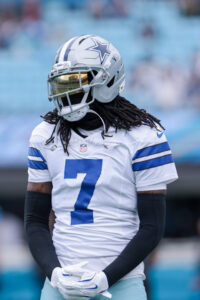 The move will clear the path for Diggs to return from a two-month absence caused by a lingering knee injury and a concussion. However, he is unlikely to return to the starting role he occupied at the beginning of the year.
The move will clear the path for Diggs to return from a two-month absence caused by a lingering knee injury and a concussion. However, he is unlikely to return to the starting role he occupied at the beginning of the year.
Diggs’ recovery and return to the field has been somewhat of a saga. He was designated to return from IR at the end of November and practiced for two weeks in a limited capacity. Diggs said he was expecting to play in Week 15 but was not activated ahead of the game. He clarified this week that he was healthy enough to play and still did not know why he was not activated, though he still was a limited participant in practice.
The Cowboys will make the procedural move to activate Diggs so that he does not revert to season-ending injured reserve, but that is no guarantee of a game day role. Recent updates have indicated a disconnect between player and team with some believing that the two sides will part ways this offseason. Diggs and the Cowboys have both stated that they envision their partnership extending into 2026, but most teams and players give that kind of an answer to such questions.
Starting cornerback DaRon Bland has been ruled out for Sunday’s matchup against the Chargers, so the Cowboys might need Diggs at some point during the game. He appears to be ready to play, but may no longer be a core part of defensive coordinator Matt Eberflus‘ plans for this season. With Dallas eliminated from the playoffs and Diggs’ injury history, the team may be hoping that he can avoid a re-aggravation this season that could affect him into 2026.
Cowboys CB DaRon Bland May Undergo Foot Surgery, Likely Destined For IR
DaRon Bland is facing yet another foot surgery. According to ESPN’s Todd Archer, the Cowboys cornerback is seeking a second opinion on a foot injury that may ultimately require surgery.
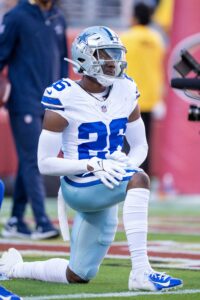 [RELATED: Cowboys CB Trevon Diggs Says He Is Healthy Enough To Play]
[RELATED: Cowboys CB Trevon Diggs Says He Is Healthy Enough To Play]
Bland missed 10 games in 2024 thanks to a stress fracture in his foot. The fourth-year player also missed a pair of games earlier this season with a foot issue, and he’s popped up on the injury report a few times this year with the same injury.
According to Archer, Bland hasn’t scheduled a surgery yet. Still, it sounds like the injury will likely sideline the defensive back for the rest of the 2025 campaign. Archer opines that Bland is likely destined for the injured reserve, which would keep him off the field for the rest of the regular season.
The former fifth-round pick emerged as a starter during his rookie campaign before having a prolific sophomore season. Bland finished that 2023 season with nine interceptions, five of which were returned for touchdowns (an NFL record). Unfortunately, the cornerback has been limited to only 19 appearances since that time. After grading Bland as the second-best CB in the NFL in 2023, Pro Football Focus has ranked the former All-Pro in the middle of the pack at his position in 2024 and 2025.
The Cowboys will be especially cautious with Bland’s injury after the team handed him a lucrative extension this past offseason. The cornerback inked a four-year, $92MM deal, including $50MM in guaranteed money. That extension has yet to kick in, and the Cowboys will surely want Bland to get past this persistent foot issue before he sees a significant jump in his cap hit.
As the Cowboys look to keep their slim playoff hopes alive, it will be interesting to see how the coaching staff manages their CB depth chart. Trevon Diggs was a surprise inactive for Sunday’s game against the Vikings, but the cornerback later revealed that he was healthy enough to play. After moving on from Kaiir Elam earlier this season, the Cowboys are currently eyeing a cornerback grouping that consists of Shavon Revel, Reddy Steward, and Caelen Carson.
Cowboys DC Matt Eberflus On Hot Seat?
DECEMBER 18: When speaking to the media on Thursday, Eberflus acknowledged (via Machota) the Cowboys’ defensive performance down the stretch will play a role in deciding his status for 2026. He added an endorsement from the organization is not necessary at this point, although in the absence of a definitive one there will no doubt continue to be speculation about a potential change on the sidelines this offseason. Eberflus will call plays from the booth moving forward after doing so from the field.
DECEMBER 17: Although Dallas leads the NFL in total offense and ranks fifth in scoring, the team is all but guaranteed to miss the playoffs. After dropping to 6-7-1 with a loss to the Vikings in Week 15, the Cowboys’ chances of earning a postseason bid are under 1%, according to ESPN’s Football Power Index. It’s fair to place most of the blame for the Cowboys’ lackluster season on their defense.
Under first-year coordinator Matt Eberflus, previously the Bears’ head coach, Dallas sits 29th in total defense. Only the lowly Bengals have allowed more points than the Cowboys.
With the Cowboys’ defense off to a dreadful start in 2025, owner Jerry Jones and executive vice president Stephen Jones gave public votes of confidence to Eberflus leading up to the Nov. 4 trade deadline. The Cowboys then made noteworthy deals to acquire defensive tackle Quinnen Williams from the Jets and linebacker Logan Wilson from the aforementioned Bengals. They also saw linebacker DeMarvion Overshown and cornerback Shavon Revel return from long-term injury absences last month.
Thanks in part to an improved defense, the Cowboys ripped off three straight post-deadline wins over the Raiders, Eagles, and Chiefs. They were firmly in the playoff mix at that point, but that momentum is gone after back-to-back losses to Detroit and Minnesota.
The Cowboys gave up 44 points against the Lions and surrendered another 34 to the Vikings. J.J. McCarthy, among the league’s least effective quarterbacks this year, played one of the best games of his young career. McCarthy finished 15 of 24 for 250 yards, three touchdowns (two passing, one rushing), and an interception.
After McCarthy helped take a sledgehammer to the Cowboys’ fading playoff hopes, Jerry Jones sounded less bullish about Eberflus. It seems he’ll be under evaluation for the rest of the season.
“The adjustments that we should be making (defensively) should be with these next three games in mind,” Jones said on Sunday night (via Jon Machota of The Athletic). “With three games left in the short time that we’ve got to play them in, then that will impact any adjustments that you make regarding coaching with the time frame we’re dealing with. That’s a legit question.”
One of the “adjustments” Dallas made in Week 15 was to give more playing time to Wilson. Jerry Jones noted that was a possibility leading up to the game (via Calvin Watkins of the Dallas Morning News). Wilson then made his first start as a Cowboy and logged more defensive snaps than Kenneth Murray (29 to 22), but the results were uninspiring. Both players recorded one tackle apiece.
Asked about Wilson and Murray, head coach Brian Schottenheimer said (via Joseph Hoyt of the Dallas Morning News) that the two “can improve in certain areas, and it’s kind of pretty consistent throughout our football team right now.”
Eberflus may need to get more from Wilson, Murray, and the rest of his defense if he’s going to remain on Schottenheimer’s staff next year. Otherwise, Eberflus could follow Mike Zimmer as the team’s second consecutive one-and-done defensive coordinator. The Cowboys haven’t had stability there since Dan Quinn‘s three-year run from 2021-23.
Cowboys Hope To Retain CB Trevon Diggs Beyond 2025
Given the way Trevon Diggs‘ season has played out, many have pointed to a Cowboys departure being likely this spring. The team’s preference would be to keep him in the fold, however. 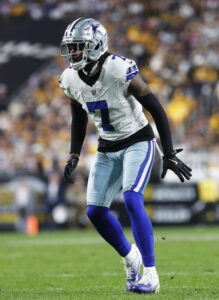
Diggs has been limited to just six games this season. The two-time Pro Bowl corner remains on injured reserve at this point even though he believes he is healthy enough to play. As he awaits a return to action, further clarity has emerged regarding Diggs’ situation.
Upon speaking with the 2021 All-Pro, NFL Network’s Jane Slater learned the home incident which resulted in his concussion was “far less nefarious” than speculation regarding the situation has implied (video link). Diggs has also been rehabbing a knee injury while recovering from the concussion, and his practice window opened on November 30. He will therefore need to be activated in the coming days to be able to play in Dallas’ three remaining games.
The relationship between team and player has reportedly worsened over time in 2025. Head coach Brian Schottenheimer has been in contact with Diggs about not only his health situation but also the need to meet the team’s standards regarding on- and off-field matters. Under new DC Matt Eberflus, the Cowboys have largely struggled while attempting to implement his zone-heavy scheme. Diggs’ past success has come in man coverage, and he conceded to Slater improvement is needed if he is find his footing in the Eberflus-led defense.
Per Slater, the Cowboys “would love” to have Diggs in place beyond the closing stages of the 2025 season. She adds the 27-year-old’s preference would also be to remain in Dallas. Improved play down the stretch would be critical in this case given the ease with which a parting of ways could take place this spring. Diggs’ contract runs through 2028, but it does not contain any guarantees after this year. The Cowboys could release him and generate over $12.5MM in cap savings while incurring a dead money charge of just $5.88MM.
Of course, it is far from certain if Eberflus will still be at the helm of Dallas’ defense in 2026. A change on the sidelines could alter Diggs’ future in Dallas. For now, though, his attention will be aimed at remaining on the field for the final three games of the campaign and potentially playing his way into a more stable Cowboys tenure.
Cowboys Open Up Practice Windows For Three Players
The Cowboys are dangerously close to being eliminated from the playoffs, but they haven’t stopped fighting yet. With three weeks left in the season, now’s the time to open 21-day practice windows for players hoping to make a return from injured lists this year.
To that point, Dallas opened the practice window for defensive end Payton Turner, who had been designated to return at the roster cut deadline in August, designated seventh-round rookie running back Phil Mafah to return from injured reserve, and designated cornerback Josh Butler to return from the reserve/physically unable to perform list, per ESPN’s Todd Archer. The three players have been on their respective injured lists since before the season began.
The Cowboys signed Turner to a one-year deal early into free agency to build depth behind a group that, at the time, consisted of Micah Parsons, Sam Williams, and Marshawn Kneeland. To date, only Williams remains after the Parsons trade and Kneeland’s tragic passing. Turner’s depth ended up being a non-factor, considering he spent the first 15 weeks of the season on IR, but if he returns, he’ll now add depth behind Donovan Ezeiruaku, Dante Fowler, Jadeveon Clowney, and Williams.
Butler went undrafted out of Michigan State all the way back in 2020, and after a short stint in the short-lived The Spring League and a strong season in the USFL, Butler earned himself a chance in Dallas in 2023. The next year, he made his NFL debut and, two games later, made his first of three consecutive starts. His quick rise came to an unfortunate end, though, when he tore his ACL, ending his debut NFL season.
Mafah, a two-year starter at Clemson, was one of two rookies the team drafted this year. He suffered a shoulder injury in the Cowboys’ final preseason game, and it was announced that he would eventually be put on IR. With the team opting to assign its two allotted pre-deadline return designations to Turner and wide receiver Jonathan Mingo, they opted to keep Mafah on the initial 53-man roster, so they could immediately place him on IR the next week and give him a chance to return later into the year, as well.
There is no longer the usual pressure to get activated within the 21-day window as we only have three weeks remaining in the regular season. The 21-day window will take them past the Week 18 slate of games, so being reverted to season-ending IR would not the worst fate. Still, these three will be working hard to get onto the field in 2025 and help their team push for a still technically possible playoff berth, and at worst, they’ll give the Cowboys three more bodies at practice for the remainder of the season.
2025 NFL Dead Money, By Team
As we head toward the playoffs, three NFL teams are carrying more than $100MM in dead money. That represents more than a third of the salary cap. The 49ers are also on track to make the playoffs with more than $100MM allocated to players no longer on their 53-man roster. Here is where the 32 teams stand for dead money (via OverTheCap) with three weeks left in the regular season:
- New Orleans Saints: $107.83MM
- San Francisco 49ers: $103.77MM
- New York Jets: $102.1MM
- Las Vegas Raiders: $87.79MM
- Philadelphia Eagles: $87.27MM
- Seattle Seahawks: $86.1MM
- Jacksonville Jaguars: $85.49MM
- Cleveland Browns: $83.22MM
- Miami Dolphins: $72.45MM
- Houston Texans: $66.44MM
- Tennessee Titans: $59.42MM
- Green Bay Packers: $57.98MM
- Los Angeles Rams: $56.23MM
- New England Patriots: $50.56MM
- Denver Broncos: $42.78MM
- Dallas Cowboys: $41.34MM
- Detroit Lions: $40.71MM
- Tampa Bay Buccaneers: $40.39MM
- Los Angeles Chargers: $38.78MM
- Baltimore Ravens: $38.38MM
- Buffalo Bills: $37.58MM
- Carolina Panthers: $36.55MM
- New York Giants: $33.74MM
- Pittsburgh Steelers: $33.7MM
- Minnesota Vikings: $30.6MM
- Washington Commanders: $27.29MM
- Atlanta Falcons: $27MM
- Cincinnati Bengals: $20.99MM
- Kansas City Chiefs: $20.33MM
- Indianapolis Colts: $17.37MM
- Arizona Cardinals: $16.51MM
- Chicago Bears: $8.6MM
 The $100MM trio dwarfs last year’s leaders — the Broncos — in this unwanted area. The Saints began taking some overdue medicine for their cap-gymnastics past by trading Marshon Lattimore last year. That move coming after June 1 pushed $31.67MM onto New Orleans’ 2025 cap sheet. Derek Carr also counts $19.2MM on this year’s Saints cap, while Ryan Ramczyk‘s retirement covers more than $11MM.
The $100MM trio dwarfs last year’s leaders — the Broncos — in this unwanted area. The Saints began taking some overdue medicine for their cap-gymnastics past by trading Marshon Lattimore last year. That move coming after June 1 pushed $31.67MM onto New Orleans’ 2025 cap sheet. Derek Carr also counts $19.2MM on this year’s Saints cap, while Ryan Ramczyk‘s retirement covers more than $11MM.
The Carr punishment covers $55.88MM in total, meaning nearly $37MM from the QB’s retirement will land on New Orleans’ 2026 payroll. Mickey Loomis‘ spree of restructures on that contract created that inflated figure.
Deebo Samuel brought a receiver-record dead money total to the 49ers, who absorbed $34.12MM by trading the seventh-year veteran in March. The second leg of the post-June 1 Arik Armstead transaction from 2024 created a $15MM dead cap hit this year, with void years on Charvarius Ward‘s deal covering more than $12MM.
Gang Green took on barely $20MM combined from the Sauce Gardner and Quinnen Williams trades and will do the same next year, reflecting the low signing bonus figure on the Gardner extension. The Jets, though, have taken $56MM in total from the Aaron Rodgers release ($21MM this year, $35MM next). That is the second-highest total dead cap hit in NFL history.
The team that authorized the highest dead money sum in league annals — Denver, via the 2024 Russell Wilson release — is still carrying $32MM on that contract. It comes off the books next year, and the Broncos do not have any other player counting more than $3MM in dead cap on their 2025 payroll.
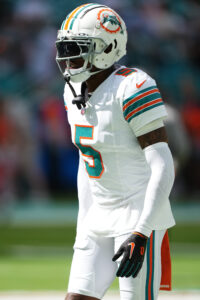 The Eagles and Seahawks are also moving toward the playoffs with higher dead money counts compared to the 2024 Broncos, though it should be noted the cap’s $24MM increase from last year plays into this. Philadelphia is still carrying a combined $26MM from the 2024 Jason Kelce and Fletcher Cox retirements. Josh Sweat void years also comprise $16.44MM of this year’s cap. The Seahawks’ D.K. Metcalf trade brought $21MM in dead cap, while Geno Smith, Tyler Lockett and Dre’Mont Jones combine to cover more than $41MM in dead money.
The Eagles and Seahawks are also moving toward the playoffs with higher dead money counts compared to the 2024 Broncos, though it should be noted the cap’s $24MM increase from last year plays into this. Philadelphia is still carrying a combined $26MM from the 2024 Jason Kelce and Fletcher Cox retirements. Josh Sweat void years also comprise $16.44MM of this year’s cap. The Seahawks’ D.K. Metcalf trade brought $21MM in dead cap, while Geno Smith, Tyler Lockett and Dre’Mont Jones combine to cover more than $41MM in dead money.
Amari Cooper and Za’Darius Smith‘s 2024 Cleveland exits via trade tagged the Browns with more than $36MM in dead money together, while the Dolphins are dealing with more than $30MM combined from the post-June 1 designations on Xavien Howard and Jalen Ramsey. The latter counts $15.7MM in dead money this year and $20.9MM in 2026. That eclipses Lattimore’s defender-record total for dead cap.
Cowboys CB Trevon Diggs Says He Is Healthy Enough To Play
Cowboys cornerback Trevon Diggs was a surprise inactive for Sunday’s game against the Vikings, sparking questions about his future in Dallas.
 Diggs, 27, has not played since Week 6 due to a concussion and a knee injury, though it was not the knee that required surgery in 2023 and 2024. He was placed on injured reserve on October 25 and returned to practice at the end of November.
Diggs, 27, has not played since Week 6 due to a concussion and a knee injury, though it was not the knee that required surgery in 2023 and 2024. He was placed on injured reserve on October 25 and returned to practice at the end of November.
After two weeks of practice, Diggs appeared ready to play against the Vikings and said he was expecting to do so. Instead, he will have to wait another week before being activated from IR and returning to in-game action. Even when he does, he does not seem guaranteed to have a role in the defense.
“Trevon and I sat down and we had a very detailed conversation on Saturday,” Schottenheimer said on Monday (via ). “I told him not only the reasons why but also the standards and expectations.”
Diggs said (via ESPN’s Todd Archer) that he was “upset” and did not know why he was inactive despite a Saturday sit-down with head coach Brian Schottenheimer.
““This week, I showed them what they wanted to see in practice and it’s still the same result,” Diggs said. “I don’t know what else I need to do or what to show. At this point I feel like it’s not even, it’s not up to me or what I do. It’s really up to them, and what they want to do. I’m just showing up every day. I’m going to go to work.”
Diggs, a 2020 second-round pick, took over a starting cornerback job as soon as he arrived in Dallas, but spent four games on injured reserve due to a foot fracture. He broke out in 2021 with 21 passes defended and a league-high 11 interceptions, though he also had a tendency to give up big plays. Diggs did not have as much ball production the following year, but his overall coverage improved substantially. That earned him a five-year, $97MM extension; since signing it, he has only played in 19 games.
Between the injuries and a seemingly strained relationship between player and team, Diggs could be on his way out of Dallas this offseason. He is owed $47MM over the next three years, per OverTheCap; a post-June 1 cut would save the Cowboys $15.5MM in 2026 cap space with $2.9MM in dead money in 2026 and 2027.
The Cowboys signed DaRon Bland to an extension to a four-year, $90MM extension – a far better value than Diggs’ deal – just before the season started. In addition to making outside additions, Dallas could also roll with 2024 fifth-rounder Caelen Carson and 2025 3rd rounder Shavon Revel, who have both seen plenty of playing time amid Diggs’ absence.

